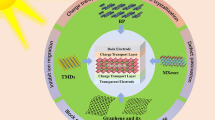Abstract
We have investigated the degradation of P3HT:PCBM (poly(3-hexylthiophene):6,6-phenylC61 butyric acid methyl ester) solar cell beyond 150 h of fabrication in continuation to our earlier reported work up to 150 h of fabrication. The current- voltage characteristics of degraded Indium tin oxide/poly(3,4-ethylenedioxythiopene):poly(styrenesulfonate)/poly(3-hexylthiophene):6,6-phenylC61 butyric acid methyl ester/Aluminum (ITO/PEDOT:PSS/P3HT:PCBM/Al) solar cell can be explained by considering the tunneling current through electrode interfaces, increase in both the interface states density and the thickness of interface with time for150-200 h. Beyond 200 h of fabrication, a significant reduction in the occupation probability at the electrode interfaces explains the experimental results up to 300 h fairly well. Calculations based on realistic parameters and activity at both the electrode interfaces (ITO/PEDOT:PSS and P3HT:PCBM/Al) confirm that degradation at P3HT:PCBM/Al interface is more prominent than that at ITO/PEDOT:PSS interface.




Similar content being viewed by others
References
Cai W, Gong X, Cao Y (2010) Sol Energy Mater Sol Cells 94:114–127
Song QL, Li F, Yang H, Wu HR, Wang XZ, Zhou W, Zhao JM, Ding XM, Huang CH, Hou XY (2005) Chem Phys Lett 416:42–46
Liao KS, Yambem SD, Haldar A, Alley NJ, Curran SA (2010) Energies 3:1212–1250
Voroshazi E, Verreet B, Buri A, Müller R, Di Nuzzo D, Heremans P (2011) Org Electron 12(5):736–744
Street RA, Schoendorf M, Roy A, Lee JH (2010) Phys Rev B 81:205307–205318
Monestier F, Simon JJ, Torchio P, Escoubas L, Flory F, Bailly S, de Bettignies R, Guillerez S, Defranoux C (2007) Sol Energy Mater Sol Cells 91:405–410
Lacic S, Inganäs O (2005) J Appl Phys 97:124901–124907
Bernède JC, Godoy A, Cattin L, Diaz FR, Morsli M, del Valle MA (2010) Solar energy, edited by Radu D Rugescu, InTech
Moliton A, Nunzi JM (2006) Polym Int 55:583–600
He C, Zhong C, Wu H, Yang R, Yang W, Huang F, Bazan GC, Cao Y (2010) J Mater Chem 20:2617–2622
Kim HJ, Lee HH, Kim J-J (2009) Macromol Rapid Commun 30:1269–1273
Ishii H, Sugiyama K, Ito E, Seki K (1999) Adv Mater 11:605–625
Pillai S, Green MA (2010) Sol Energy Mater Sol Cells 94:1481–1486
Kang MG, Park HJ, Ahn SH, Guo LJ (2010) Sol Energy Mater Sol Cells 94:1179–1184
Guerrero A, Marchesi LF, Boix PP, Ruiz-Raga S, Ripolles-Sanchis T, Garcia-Belmonte G, Bisquert J (2012) ACSNANO 6:3453–3460
Toyoshima S, Kuwabara K, Sakurai T, Taima T, Saito K, Kato H, Akimoto K (2007) Jpn J Appl Phys 46:2692–2695
Jorgensen M, Norrman K, Krebs FC (2008) Sol Energy Mater Sol Cells 92:686–714
Nguyen LH, Hoppe H, Erb T, Gunes S, Gobsch G, Sariciftci NS (2007) Adv Funct Mater 17:1071–1078
Chawdhury N, Kohler A, Harrison MG, Hwang DH, Holmes AB, Friend RH (1999) Synth Met 102:871–872
Arora S, Singh V, Arora M, Tandon RP (2011) Evaluating effect of surface state density at the interfaces in degraded bulk heterojunction organic solar cell. Physica B. doi:10.1016/j.physb.2011.08.086
Vázquez H, Flores F, Kahn A (2005) IPAP Conf. Series, Proc. Int. Symp. Super-Functionality Organic Devices 6:1–5
Schafferhans J, Baumann A, Deibel C, Dyakonov V (2008) Appl Phys Lett 93:093303
Kumar P, Jain SC, Kumar V, Chand S, Tandon RP (2009) J Phys D: Appl Phys 42:055102–055108
Biswas S, Mansingh A (1992) J Phys D: Appl Phys 25:100–105
Dennler G, Scharber MC, Brabec CJ (2009) Adv Mater 21:1323–1338
Ouyang J, Chu CW, Chen FC, Xu Q, Yang Y (2005) Adv Funct Mater 15:203–208
Schafferhans J, Baumann A, Wagenpfahl A, Deibel C, Dyakonov V (2010) Org Electron 11:1693–1700
Goswami A, Goswami AP (1977) Pramana 8:335–347
Kolodzey J, Chowdhury EA, Adam TN, Qui G, Rau I, Olowolafe JO, Suehle JS, Chen Y (2000) IEEE T Electron Dev 47:121–128
Lin YJ (2008) J Appl Phys 103:063702–063705
Acknowledgement
Authors wish to thank Department of Science and Technology Purse Grant, INDIA for financial support. We want to further thank Prof P.C. Mathur, Department of Electronic Science, South Campus, University of Delhi, Dr. M. Aslam Parvaiz, Principal, Zakir Husain College, University of Delhi and Dr. Pankaj Kumar, Scientist B, National Physical Laboratory for their valuable suggestions and support.
Author information
Authors and Affiliations
Corresponding author
Rights and permissions
About this article
Cite this article
Singh, V., Arora, S., Bhatnagar, P.K. et al. Degradation in bulk heterojunction organic solar cells: changes in electrode interface and reduction in the occupation probability of the interface states. J Polym Res 19, 9899 (2012). https://doi.org/10.1007/s10965-012-9899-0
Received:
Accepted:
Published:
DOI: https://doi.org/10.1007/s10965-012-9899-0




